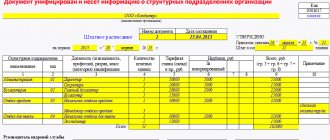The organization of accounting for any company requires strict accounting of fixed assets: the means of labor with which products, work or services are produced. One of the main mechanisms for monitoring the safety and movement of OSes is the assignment of inventory numbers to them: unique digital and symbol combinations that do not change throughout the entire operational life of the OS. When assigning an inventory number, certain techniques are used that allow you to encode in numbers and symbols all the basic information about each OS. In addition to the operating system, inventory numbers are assigned to some other objects important for the functioning of the company.
Inventory number and features of its use
An inventory number is assigned to a property at the time it is accepted for registration. After this, it acquires the status of an inventory object - a control unit. The number is applied to the object using durable paint, a barcode, engraving, using a token that cannot be quickly and discreetly removed, or in another similar way. The number must be applied so that during an inventory it can be easily and without errors identified with the BU data.
The main objects in relation to which management is organized in this way and control is exercised are:
- OS - fixed assets, objects of property of the organization that have been in operation for more than a year, are intended for production needs, and the cost of which is a legally defined amount;
- intangible objects, assets (IMA) - these include products of intellectual labor, for example, technological developments, software development, trademarks, brand names and other objects that do not have a material form, but which can in the future bring material benefits (see. Civil Code of the Russian Federation Article 1225-1, PBU 14/07);
- non-produced objects, assets - these are natural objects, subsoil, lands, water bodies, etc.
Objects costing less than 3 thousand rubles. no inventory number needed.
The following mandatory requirements apply to inventory numbers:
- they should not be duplicated;
- they must be assigned in order.
In addition, when using inventory numbers in accounting records, it is important to be guided by the following important information:
- The inventory number is applied in the presence of a commission specially created for this purpose and recorded in the inventory number journal.
- If the inventory object is a whole consisting of separate functional parts, a number is applied to each part.
- Moving an inventory item within the organization or its divisions is not a reason to change the number or adjust it. The inventory number does not change during the entire operation of the object to which it is assigned.
- If fixed assets are leased by a company, they are usually accounted for by numbers assigned by the lessor. At the same time, from Resolution 11 of the Arbitration Court of Appeal No. A55-24142/2013 dated 04/28/14, it follows that when the rights to an inventory object are transferred, for example, when signing a leasing agreement, it may be assigned a new inventory number of the organization that acquired such rights. It is argued that the assignment of inv. numbers are an internal matter of the organization.
- The inventory number of an object deregistered (sold, written off, etc.) cannot be assigned to another object in the same organization.
In whose competence?
How is CN assigned to real estate? What organ does this?
This is handled by a special body called the cadastre, which is a division of Rosreestr. Who assigns CN to a real estate property?
It is the employees of this body who check the compliance of all documents relating to the property with each other - technical plan, certificate of ownership of the object, applications, and may refuse to provide such a service.
Read about the procedure for providing information about real estate from the State Property Committee in our article. Find out also how to include a building, structure or unfinished construction project in the cadastre.
Normative base
The legislation does not contain a clear regulatory framework regulating step by step how to assign inventory numbers. There is Instruction of the Ministry of Finance No. 174n (Appendix 2), containing general instructions on the assignment of inventory numbers. In addition, Instruction No. 157n (clause 46) applies to municipal unitary enterprises, where the procedure for such appointment is discussed in somewhat more detail. Guided by these documents and current legislation, the organization independently develops the structure of inventory numbers and the procedure for assigning them, enshrining it in local regulations (accounting policies, etc.). The procedure for assigning numbers can also be regulated at the departmental level, established by a higher organization.
Legislative regulations
When is a property title assigned to real estate?
This happens at the time information about the property is entered into a special register - the State Real Estate Cadastre (GKN).
In order for real estate to be included in the state database and acquire its own digital identification code , it must be registered with Rosreestr.
What laws govern it? Registration of a house, apartment, room, office, land plot is subject to Federal Law No. 221-FZ “On the State Real Estate Cadastre”.
This legislative document has a number of additions and changes , but it provides for everything - from the list of documents to the indication of the applicant’s waiting time at the window.
The algorithm for assigning numbers itself is provided for by the Decree of the Government of the Russian Federation of April 15, 1996 No. 475 “On approval of the Regulations on the structure and procedure of accounting...”.
You can learn about the basic principles and problems of maintaining state cadastral registration of real estate from our article.
Application for state cadastral registration of changes in real estate.
Inventory number structure
This characteristic largely depends on the internal needs of the company:
- its size;
- structure and presence of divisions;
- opportunities and resources in the process of organizing accounting.
Thus, a small organization that has a minimum number of divisions and a limited number of accounting objects can use simple numbering of the form: 01, 02, 03, etc. If objects are located on different accounting accounts, in different departments, it is advisable to include this information in the inventory number, for example:
- 04 — intangible assets accounting account;
- 03 - code of the department in which the object is located;
- 02 is the sequential number of this object in the division.
We receive inventory number 040302.
It is also acceptable to use alphabetic characters and abbreviations for the names of departments:
- "AXO" - for accounting and financial services of the economic service;
- "SKL" - warehouse, etc.
Attention! When determining the structure of an object’s inventory number, it is necessary to take into account the possibility of its movement across company divisions. Information must be generated in such a way as to ensure error-free identification of an object with BU data.
The procedure must be recorded in the company's accounting policies.
Main stages of inventory:
1. Preparatory stage:
- preparation of an order to conduct an inventory;
- formation of an inventory commission;
- determining the timing and types of inventory property;
- receiving receipts from financially responsible persons, etc.
- printout of inventory lists of inventory items (form No. INV-3) separately for each financially responsible person.
The main document that determines the procedure for conducting an inventory is the Methodological Instructions for Inventorying Property and Financial Liabilities, approved by Order of the Ministry of Finance of Russia dated June 13, 1995 No. 49. They also contain forms for recording inventory results, which are approved by Resolution of the State Statistics Committee of Russia dated August 18, 1998 No. 88 (as amended on March 27, 2000).
2. Weighing, measuring, counting, identifying and checking the actual availability of property and liabilities, as well as drawing up inventories.
3. Comparison of inventory data with accounting data: discrepancies are identified, matching statements are compiled and the reasons for the discrepancies are determined.
4. Registration of inventory results. At this stage, accounting data is brought into line with the results of the inventory; persons guilty of incorrect accounting of property are brought to administrative responsibility.
When correcting errors based on inventory results, you need to follow two rules:
- Firstly, the inventory must be completed before the reports are signed and submitted to the tax office.
- Secondly, error correction entries are dated to the end date of the inventory count or December 31 of the reporting year.
Changes cannot be made to the approved and submitted financial statements. In such a situation, all errors are corrected this year.
Typical mistakes when assigning inventory numbers
Inaccuracies and errors made can not only bring chaos to the process of accounting for inventory items, but also lead to negative consequences when conducting external control. This is especially true for municipal unitary enterprises, other government organizations, and subordinate organizations. The most common ones are listed below:
- Discrepancies with the accepted accounting policy: arbitrary change in the length of the number, inclusion of letter designations in it, or, conversely, ignoring them in practice.
- Applying the number in a way that does not ensure its safety during the entire operation of the object: with weak dye, by gluing labels, etc.
- Failure to affix an inventory number due to the alleged impossibility of affixing it. Indeed, instruction 157n allows you not to physically affix this number, but only to enter it into the control unit registers under appropriate conditions. However, if the control commission discovers that the application was in fact possible, the organization may have problems.
- Applying an inventory number to objects arbitrarily, unnecessarily. Example: numbering an object worth less than 3,000 rubles.
Main
- Inventory number is a mandatory feature of an inventory item.
- Determining the structure, length and other features of an inventory number is an internal matter of the company. In this case, the procedure must be reflected in local regulations and take into account current legislative acts, including, if necessary, those of an intradepartmental nature.
- Objects costing less than 3 thousand rubles. are not subject to numbering.
- The basic and mandatory requirements for an inventory number are uniqueness and consistency.
Application for amendments to cadastral registration: how is it drawn up?
A 5-sheet form - this is the format of the application that the owner of the property where the cadastral number must change must draw up.
- Point 1 - the key information that needs to be filled in here is the compliance of the proposed reasons for the adjustments; one of them (or several) should be checked.
- Clause 2 – method of notifying the applicant (personal delivery, e-mail, paper version, as well as actual delivery address).
- Point 3 – here the owner needs to correctly and reliably indicate all personal data, which will be carefully double-checked by department specialists.
- Clause 4 contains a list of all related documents. In paragraphs 5 and 6, the applicant consents to the processing of his personal data and certifies the accuracy of all information with his signature.
Responsibility for failure to take inventory
The law does not provide for liability for failure to carry out an inventory. However, the inspection may fine you for unreliable accounting and reporting data (Article 120 of the Tax Code of the Russian Federation; Article 15.11 of the Code of Administrative Offenses of the Russian Federation). True, to do this she will have to find the discrepancies between the credentials and the real ones herself. Although this is not easy to do in previous periods, it is not impossible.
We recommend watching the recording of the webinar “How to conduct and process an inventory in accounting and tax accounting.” The lecturer will use practical examples to show how to make adjustments in accounting if surpluses or shortages are identified during inventory. He will also examine the most controversial and challenging issues that arise during the inventory process.
Reply from 12/08/2015:
Instruction No. 174n (Appendix No. 2 to Order No. 174n of the Ministry of Finance of Russia dated December 16, 2010) does not contain any special instructions regarding the procedure for generating inventory numbers of fixed assets in budgetary institutions.
The only norm of legislation on accounting in state (municipal) institutions regulating the procedure for assigning inventory numbers to fixed assets is clause 46 of Instruction No. 157n (Appendix No. 2 to Order of the Ministry of Finance of Russia dated December 1, 2010 No. 157n).
According to paragraph 46 of Instruction No. 157n, each inventory item of real estate, as well as an inventory item of movable property, except for objects worth up to 3,000 rubles inclusive and objects of the library collection, regardless of their value, is assigned a unique inventory serial number (hereinafter referred to as the inventory number) regardless of whether it is in operation, in reserve or in storage.
There are two requirements here:
1) The inventory number must be unique. That is, there should not be more than one fixed asset with the same inventory number. Also, paragraph 46 of Order No. 157n states that after writing off a fixed asset, it is unacceptable to reuse its inventory number.
2) The inventory number must be “serial”.
Thus, the legislation does not establish any requirements for the number of digits in the inventory number of a fixed asset and the content of these digits.
According to paragraph 46 of Instruction No. 157n, the inventory number assigned to an object must be designated by the financially responsible person in the presence of an authorized member of the commission for the receipt and disposal of assets by attaching a token to it, applying paint to the accounting object or in another way that ensures the safety of the marking. If the fixed asset object is complex (a complex of structurally articulated objects), i.e. includes separate elements (structural objects) that together form a single whole, then each such element (structural object) must be marked with an inventory number assigned to the fixed asset (complex object, complex of structurally articulated objects).
Consequently, the absence of inventory numbers on fixed assets (if it is possible to apply them) or unreliably applied inventory numbers (for example, glued with tape), the absence of inventory numbers on the components of the complex can be considered a serious violation of accounting standards.
According to clause 46 of Instruction No. 157n, the inventory number assigned to an object of fixed assets is retained by it for the entire period of its presence in the institution.
Therefore, inventory numbers cannot be changed.
General drafting rules
The legislation does not provide for a special procedure for assigning numbers. The organization has the right to independently develop these regulations. The procedure is prescribed in the accounting policy of the enterprise or another act.
The main requirement is to indicate a unique number for each object. It is unacceptable for designations to be repeated. If a fixed asset is deregistered, its number can be assigned to another object after at least 5 years.
The numbers must be sequential. In large organizations, it is better to develop guidelines for assigning codes. The number may consist of several parts: a company branch, a division, a code within a division. When transferring funds to other branches, they will not be lost. Small firms can use simple numbering starting from 1.
Method of applying the number to the OS
In the practice of accountants, there are cases when it is impossible to apply numbering to an object using accessible methods; in such situations, data about the operating system is stored only on accounting registers. Objects to be numbered can be marked using any method possible for the organization:
- Using paint and stencil:
- Apply stickers or tokens;
- Use engraved plates.
Advice. Do not forget that by applying the inventory number incorrectly, you can spoil the numbering object itself; carefully consider all the nuances before you begin to act.
The head and chief accountant of the organization must constantly monitor the correct and timely registration of the movement of fixed assets, this will ensure their safety, allow for prompt receipt of clear information, and will help in organizing the entire work of the enterprise.
Accounting for the tenant
An important point is that the leased asset, which is registered by the tenant, must strictly comply with specific requirements:
- the object is used exclusively in the main (production and economic) activities of the organization;
- the regulated useful life of this asset exceeds twelve months;
- there is a real possibility of profitable use of the fixed asset;
- the asset was acquired by the owner not for subsequent resale to third parties.
Thus, the compliance of a property object with all of the above criteria is the basis for its registration as an asset related to fixed assets.
The fact of transfer and acceptance of an asset under a lease agreement is necessarily certified by the execution of the corresponding act, which, as is known, is a necessary addition (appendix) to the agreement concluded between the lessor and the lessee.
Operating lease of fixed assets
Economic relations involving the transfer (provision) and acceptance (receipt) of a specific fixed asset item for a certain fee under temporary operation conditions are most often carried out under an operating lease.
A characteristic feature of this transaction is the immutability of the owner of the leased asset.
Operation of an asset provided under an operating lease is permitted solely for its intended purpose - only to perform production tasks.
The lessee, however, has the right to improve the technical and operational parameters of the leased equipment (asset), having previously agreed upon the relevant measures with the lessor (owner) of the fixed asset.
How to take into account the value on off-balance sheet account 001?
The fact of acceptance and registration of an asset by the tenant is recorded in the debit of account 001.
At what cost should the asset be accounted for? The fixed asset is accounted for by the lessee at the cost specified in the relevant lease agreement.
The disposal of an asset and its subsequent return to the lessor is reflected by the lessee on the credit of account 001.
By the way, account 001 refers to so-called off-balance sheet accounts in accounting.
Lease payments, which are periodically made by the tenant for the operation of the fixed asset, also require tax and, of course, accounting.
In essence, the rental fee for fixed assets is the direct costs of the tenant, reflected as part of the cost of the main or, alternatively, auxiliary production.
The specific scope of attribution of such costs is determined by the functional purpose of the leased equipment.
Postings
Payments for the lease of fixed assets are taken into account by the tenant enterprise as part of the expenses of its ordinary activities.
For tax accounting, rent is written off by the tenant as expenses that constitute the cost of services, work, and goods.
Taking into account the leased fixed assets, the lessee company draws up the following typical transactions:
| Operation (description) | Account debit | Account credit |
| The leased asset is registered | 001 | |
| The rent payment is included in the costs of the tenant company (excluding VAT) | 44,26,25,20 | 76 |
| The VAT amount is taken into account separately from the rental payment | 19 | 76 |
| The amount of VAT paid is deducted | 68 (according to VAT subaccount) | 19 |
| The rent payment is transferred to the lessor | 76 | 51 |
| The asset is returned to the lessor (upon expiration of the lease agreement) | 001 |
Depreciation
If an asset is used by an organization under an operating lease, the lessee enterprise does not charge depreciation on such an asset.
However, for tax accounting reasons, the lessee can depreciate capital investments (investments) in leased fixed assets on the following basis:
- the lessor of the fixed assets agreed in advance for the tenant to make such capital investments;
- the cost of such capital investments will not be reimbursed by the lessor to the lessee;
- such depreciation is carried out by the lessee during the term of the lease agreement;
- the amounts of such depreciation are calculated according to the regulated useful life of the leased fixed assets.









